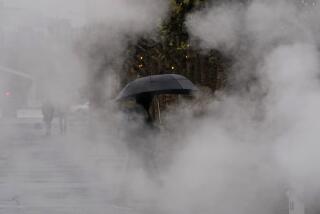Water Conservation, Reclamation Urgently Needed, Grand Jury Says
Urging an end to public apathy about water conservation, the San Diego County Grand Jury called on government and the public to adopt ambitious measures to stretch the county’s limited water supply before a crisis strikes.
At a Tuesday news conference, the chairman of the grand jury’s environmental management committee expressed concern about the pace of the region’s water-conservation efforts, endorsing rapid installation of low-volume toilets and shower-head flow restricters with the use of rebates as incentives.
“In a few months, we’re going to start rationing water. This is what I predict,” said committee chairman Richard Turnbull. “When you can’t water lawns, when you can’t play on that golf course . . . when you can’t water your shrubs, that’s when (the public) will wake up.”
The Ramona Municipal Water District, faced with a dwindling supplies in Sutherland reservoir, is the only jurisdiction in the county enforcing mandatory restrictions on lawn watering and automobile washing, said Bill Jacoby, a San Diego County Water Authority staff member.
However, the city of San Diego is considering mandatory odd-even lawn watering, and rationing might be necessary throughout the county this summer because of the continuing drought, the need for increased supply to the Los Angeles area and increased consumption of Colorado River water by the state of Arizona, Jacoby said.
Noting the county’s dependence on imported water--only 10% of the water supply is from local sources--the grand jury’s report strongly urged that the county augment underground water storage to build up a reserve in case of a natural disaster that could cut off water from Northern California.
“San Diego County must rejuvenate and utilize all underground water basins and aquifers to help build up a six-month reserve,” the report recommends. “A catastrophic flood or earthquake, resulting in severed aqueducts from Skinner Lake and Perris Lake (in Riverside County) would greatly limit imported water, especially in the northern part of the county. At the present time, the county has no reserves to meet such emergencies.”
The report also urged “rapid strides” in water reclamation, the process of cleansing sewage for reuse in irrigation, freeing potable water for consumption.
“It is imperative that reclamation programs make rapid strides before drastic measures, such as rationing, become a mandate,” the grand jury report states. “Presently, reclaimed water meets only approximately 1% of San Diego County area needs.”
The report praised the City of San Diego’s plans to reclaim as much as 135 million gallons of sewage daily, but at the news conference Turnbull backed the Sierra Club, which is attempting in federal court to force the city to mandate more rapid installation of low-volume toilets and shower flow restricters to sharply reduce water consumption.
The grand jury issued seven recommendations to the county Board of supervisors, including adoption of a master plan for use of reclaimed water for areas under county jurisdiction and enforcement by local jurisdictions of a model reclamation ordinance drawn up by the Water Authority.
The supervisors adopted a reclamation ordinance last week and changed county plumbing codes to require low-flow toilets in all new and renovated buildings starting Jan. 1--a year ahead of a similar state requirement.
However, the Water Authority believes that the county’s proposed water-reclamation plan could be jeopardized by new water-quality regulations being considered by the state Water Resources Control Board.
The proposed guidelines, now being considered by the state, would create a “tremendous compliance burden without producing any improvement in water quality,” according to Peter MacLaggan, the authority’s water-reclamation department director.
The state developed the proposed regulations, which would clamp down on chemical discharges into inland surface waters and enclosed bays and estuaries, in response to a federal Clean Water Act requirement.
“These regulations go too far,” MacLaggan said. “They set standards that are unattainable in some cases.”
If implemented, the regulations could wreck the authority’s planned method of transporting reclaimed water, along inland surface waters, from the treatment plants to where it would be used. The authority wants to reclaim 100,000 acre-feet of water annually by 2010, MacLaggan said. That amount of water would meet the residential needs of 200,000 San Diego households.
Times staff writer Greg Johnson contributed to this story.
More to Read
Sign up for Essential California
The most important California stories and recommendations in your inbox every morning.
You may occasionally receive promotional content from the Los Angeles Times.










